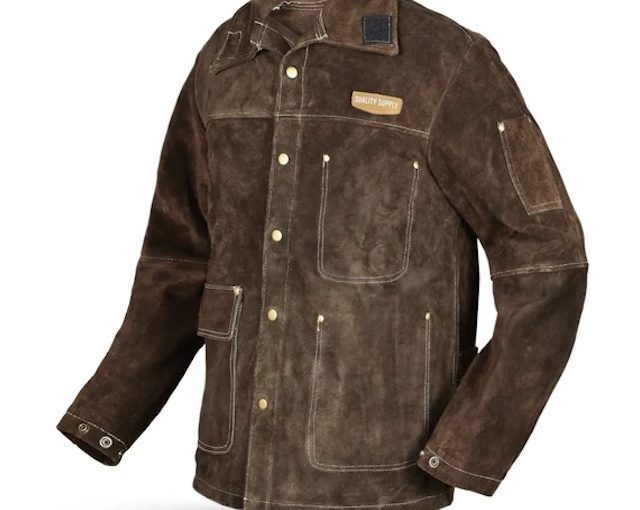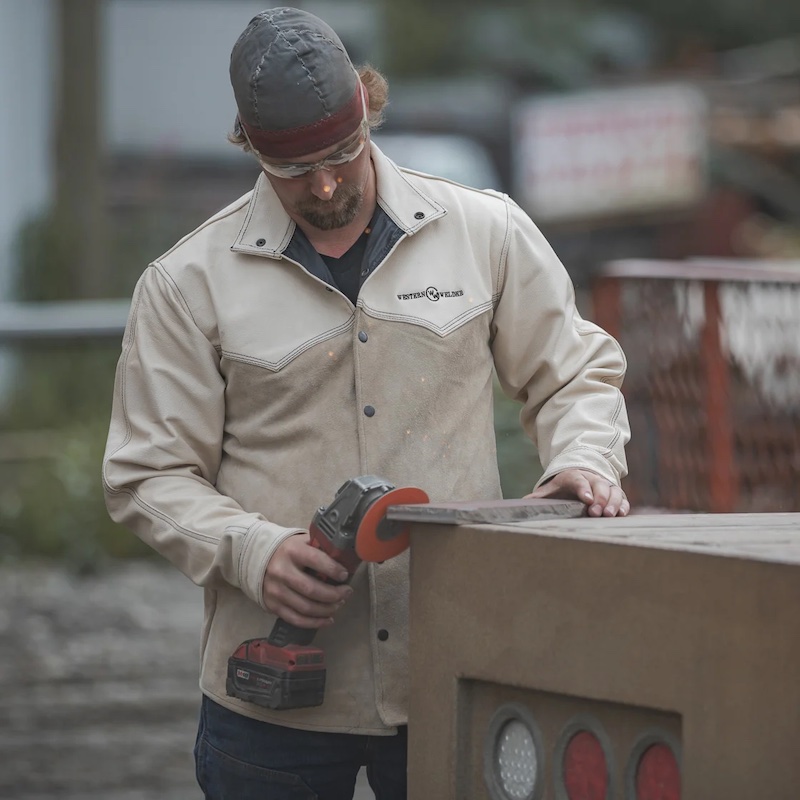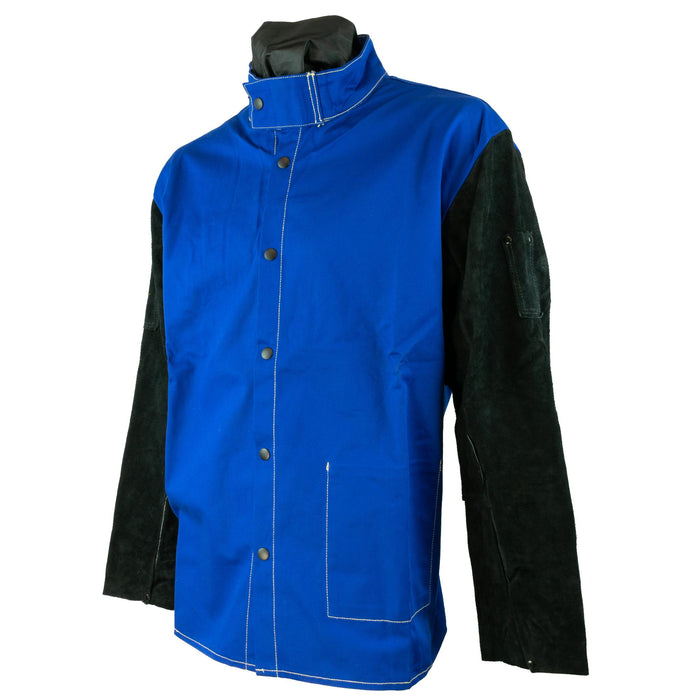Importance of Wearing a Leather Welding Jacket
Wearing a leather welding jacket is essential for safety in any welding environment. This protective gear is vital for shielding the welder’s skin from sparks, spatter, and slag, which are common byproducts of welding. These hot metals can cause not only minor burns but severe skin injuries or fire hazards if proper precautions are not taken. Hence, a high-quality leather welding jacket acts as the first line of defense.
The leather material provides a durable barrier between the intense heat generated during welding and the welder’s skin. Beyond immediate burn protection, it also minimizes long-term risks such as UV radiation exposure, which can lead to skin cancer. Moreover, a good jacket can save welders from cuts, abrasions, and other mechanical dangers that they might get from handling metalwork.
Furthermore, wearing the right gear can enhance a welder’s confidence, enabling them to focus more on their craft, knowing their safety is taken care of. By wearing a leather welding jacket, welders also comply with workplace safety regulations that mandate the use of appropriate personal protective equipment (PPE). Simply put, having and wearing the right leather welding jacket is not just a safety measure—it’s a necessary investment in a welder’s health and career.
Key Features to Look for in a Leather Welding Jacket
Material Quality and Durability
A leather welding jacket must be robust and long-lasting. Look for jackets made from high-quality, resistant leather that can withstand repetitive use and harsh conditions typical in welding environments. Check the stitching and ensure it’s heavy-duty, as seams are often the first to give way under stress. A jacket with reinforced seams and rivets at stress points will offer more durability.
Heat and Flame Resistance
Safety comes first, and heat and flame resistance are non-negotiable in a leather welding jacket. Seek out jackets treated for flame resistance and capable of withstanding extreme temperatures. Some jackets even have self-extinguishing properties, ensuring they won’t continue burning once the source of the flame is removed.
Comfort and Fit
Even the most protective jacket is useless if it’s not worn due to discomfort. Ensure the jacket allows for ease of movement — especially at the elbows and shoulders. Opt for a jacket with adjustable cuffs and collars for a customized fit. Remember, a comfortably fitting leather welding jacket is more likely to be worn consistently, offering continuous protection.
Additional Safety Features
Additional safety features can make a considerable difference. Look for jackets with high collars to protect the neck, secure closures to keep sparks out, and pockets designed to shield contents from hot debris. Some jackets also feature Kevlar threading for added strength and protection against extreme conditions.
Types of Leather Welding Jackets
When choosing a leather welding jacket, knowing the types of leather used is crucial. Different leathers offer varying levels of protection, durability, and comfort. Below we explore the most commonly used leathers in welding jackets.
Split Cowhide Leather Jackets
Split cowhide leather jackets are popular for welders due to their balance between durability and affordability. Cowhide is thick and resistant to heat, making it a strong contender for welding tasks. These jackets often have a rugged texture and can be quite stiff initially, but they become more flexible with wear. If you’re looking for a cost-effective option without compromising on essential protection, split cowhide leather jackets are a reliable choice.
Pigskin Leather Jackets
Pigskin leather jackets are more adaptable to movement and are an attractive option for welders who work in warmer climates. The leather’s natural properties allow for a level of heat resistance while keeping moisture away, reducing sweat and heat discomfort.
Full-Grain Leather Jackets
Full-grain leather is the highest quality of leather available for welding jackets. It’s made from the top layer of the hide, which includes all the grain, hence the name ‘full-grain’. This type of leather offers optimal durability and resistance to heat and abrasion. Full-grain leather welding jackets are typically more expensive, but they are an investment in long-term protection and quality. They mold to the wearer’s body over time, providing a custom fit and superior comfort.
When selecting a leather welding jacket, consider the type of leather alongside other key features like stitching, closures, and added safety enhancements. Your choice will depend on your specific welding requirements, budget, and the conditions in which you’ll be working.
Proper Maintenance of Leather Welding Jackets
Proper maintenance is key to extend the life of your leather welding jacket. By regularly cleaning and conditioning the jacket, you ensure that it remains durable and protective against harsh welding conditions. In this section, we’ll offer some essential tips for cleaning, conditioning, and storing your leather welding jacket to keep it in top-notch condition.
Cleaning and Conditioning
Regularly clean your leather welding jacket to remove dirt, grime, and welding residue. Use a brush with soft bristles to gently scrub off any surface dirt. For deeper cleaning, dampen a cloth with mild soap and water, and wipe down the jacket. Avoid harsh chemicals that can damage the leather. After cleaning, apply a leather conditioner to prevent the material from drying out and cracking. This will maintain the jacket’s flexibility and make it more comfortable to wear.
Storage and Handling Tips
Store your leather welding jacket in a cool, dry place away from direct sunlight and heat sources. Sunlight can fade the leather, and excessive heat can cause it to crack. Hang the jacket on a wide, padded hanger to maintain its shape and prevent wrinkles. Make sure the storage area is clean and dust-free. Handle your jacket with clean hands to minimize oil transfer. Proper storage and handling will help preserve the integrity of the leather, ensuring long-lasting protection for the wearer.
Top Recommended Leather Welding Brands
Choosing the right leather welding jacket brand is as important as understanding its features. Some brands stand out for their quality and have earned the trust of professional welders. Here are the top brands recommended by seasoned welders.
Professional Welder’s Picks
Professionals in the trade often prefer brands that produce jackets designed to withstand toughest conditions. These brands use top-quality materials and pay attention to the smallest details:
- Lincoln Electric: Known for their rugged durability and heat resistance, Lincoln Electric’s jackets are a top pick among professionals.
- Miller Electric: Offering a range of full-grain and split cowhide leather jackets, Miller is synonymous with quality in welding safety.
- Hobart: This brand is well-regarded for its comfortable fit and excellent protection, making it a professional welder’s choice.
Each of these brands is known for reliability, comfort, and safety. They might cost more than other options, but they are an investment in a welder’s safety.
Budget-Friendly Options
For those looking to balance cost and quality, some brands offer leather welding jackets that are protective yet more affordable:
- YesWelder: YesWelder jackets are cost-effective and provide good protection, making them a popular choice for welders on a budget.
- QeeLink: Known for their robust construction, QeeLink offers budget-friendly leather jackets without significantly compromising on quality.
- IRONCAT: IRONCAT provides a range of economical jackets that still adhere to safety standards, suitable for those starting in welding.
Selecting a leather welding jacket from budget-friendly brands allows welders to maintain safety without stretching their finances too thin. Always compare features and durability when shopping to ensure the best value for your money.
Safety Tips: Using Your Leather Welding Jacket Effectively
To maximize safety, proper use of your leather welding jacket is crucial. Here’s how to use it effectively.
Layering and Accessories
While your leather welding jacket offers substantial protection, you can enhance it. Wear flame-resistant clothing underneath. This adds an extra layer of defense. Opt for long-sleeved cotton shirts or specialized welding shirts. Avoid synthetic fabrics, as they melt under high heat, sticking to the skin and causing severe burns.
Consider accessories such as leather aprons or spats that shield your lower body. Use welding gloves to protect your hands and wrists. A welding helmet is also essential for safeguarding your face and eyes from intense light and heat. Last, wear leather boots for foot safety. This full set of gear ensures comprehensive protection during welding tasks.
Understanding Workplace Safety Standards
Familiarize yourself with workplace safety standards relevant to welding. These include guidelines from organizations like OSHA (Occupational Safety and Health Administration) and ANSI (American National Standards Institute). They provide specifications on the caliber of PPE needed, including leather welding jackets.
Compliance with these standards keeps you safe and avoids potential legal issues. Make sure you understand the requirements for your specific welding environment. Attend safety trainings and workshops to stay informed. Always inspect your leather welding jacket and other PPE before use. This habit helps catch issues like tears or broken closures that could compromise your safety.
By following these guidelines and combining a high-quality leather welding jacket with suitable layering, accessories, and adherence to safety standards, you’ll set a solid foundation for a safe welding environment.



